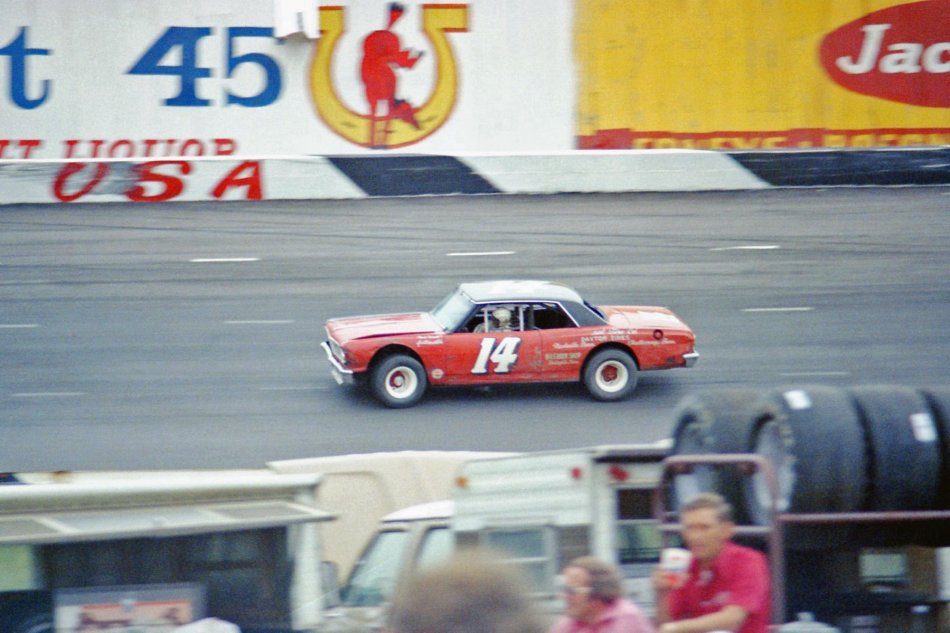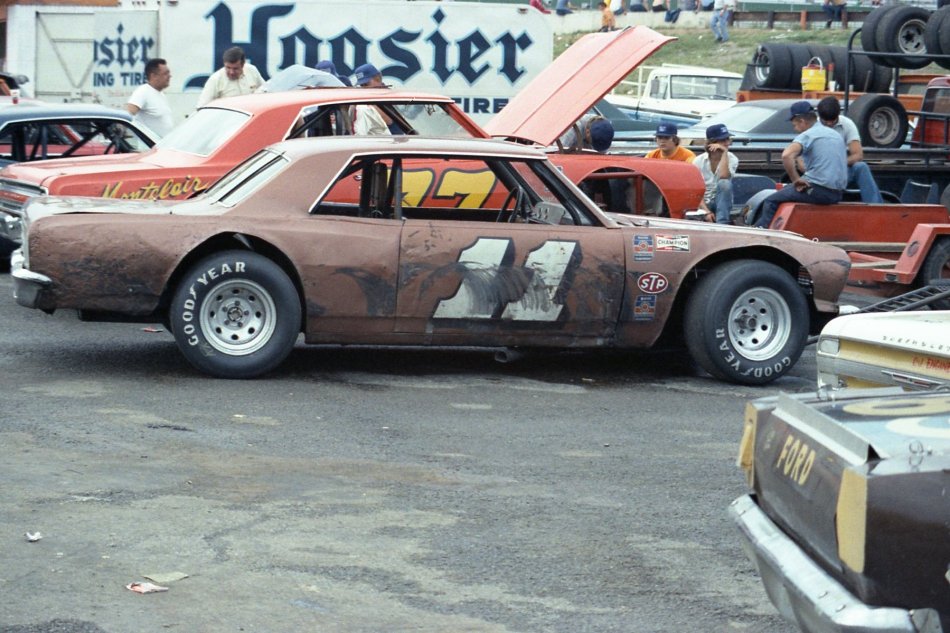From what I can remember (which is most of them) along with what I've researched in the library and the stories I've been told of the early races, every Southern 200 / 300 / 400 was a pretty special race. From the first one in 1958 being rain-shortened to Coo Coo and Red battling door-to-door in the 1966 race (a lot of which was captured on film during the making of "Hell on Wheels") to Waltrip, Ingram, and Lindley winning in the 70s to Harry Gant winning in 1978 then turning around and driving the
same car 500 more laps the same day (ok, he finished 4 laps down in 3rd in the Marty Robbins 500 - he only drove a total of 696 laps in a single day) to Skip McCord winning the 2007 edition, they all have special stories and memories.
Two of the most heartbreaking losses at the Fairgrounds occurred in the Southern 300. Bob Burcham was leading the 1964 race coming to the white flag when the engine blew. Even at that he completed enough laps to finish 3rd to Bobby Allison and Joe Lee Johnson. In the 1971 Southern, Darrell Waltrip started 3rd, took the lead after 5 laps and was never headed when his transmission gave out with 13 laps to go.
But for now, let's take a look at the 1973 Southern 400. The race had been scheduled for 300 laps since the second year (1959). For 1973 the distance was increased to 400 laps. It was a
big race on the Late Model Sportsman circuit. Seventy-one cars showed up, with fifty-nine cars attempting to qualify. That meant 26 cars took a qualifying lap and loaded up before the race even started. Stock Car Racing magazine sent a reporter and photographer to cover the race. The story appeared in the March 1974 issue. The purse for the race was over $24,000. Darrell Waltrip passed up the Grand National race at Martinsville the same weekend to run the 400.
Among the drivers who failed to qualify were 1966 Daytona Firecracker 400 winner Sam McQuagg and 1970 Grand National champion Bobby Isaac.
Qualifying times were as close as any big race I can remember at the Fairgrounds. The pole time was 21.00 and the slowest time was 21.64. That close of a spread was unheard of in those days. Part of the reason might be because it was the end of the first season racing on the lowered banks. The asphalt was still fairly new. Look in some of the photos below and you can plainly see the seam where the new asphalt for the lowered banking meets the pavement from the 1970 reconstruction.
Also notice in some of the photos that some of the billboards are missing. A huge storm blew through just a week before the race and destroyed much of the fencing around the track. The hard-working track crew didn't have time to get it all replaced.
And making more news for qualifying on the pole than those who failed to qualify was Randy Bethea out of Newport, TN. Bethea's pole run was unique for two reasons. One, he was driving one of only 4 Fords in the field. The other reason was because he was reportedly the first African-American driver to qualify on the pole for a major Nascar race.
Here's the starting lineup:
Row 1 Randy Bethea / Darrell Waltrip
Row 2 Jody Ridley / Harry Gant
Row 3 Jerry Lawley / Gary Myers
Row 4 Jack Ingram / Freddy Fryar
Row 5 Jimmy Means / John A. Utsman
Row 6 Alton Jones / Roy Milligan
Row 7 L.D. Ottinger / Neil Bonnett
Row 8 Red Farmer / Morgan Shepherd
Row 9 Brad Teague / Sam Ard
Row 10 Bob Burcham / James Ham
Row 11 Paddlefoot Wales / Steve Spencer
Row 12 Clyde Peoples / Benny Kerley
Row 13 Charlie Binkley / Charlie Chamblee
Row 14 Ray Putnum / Donnie Anthony
Row 15 Peaches Thompson / George Bonee
Row 16 Jimmy Williams / James Climer
Row 17 Jimmy Hensley
Bobby Isaac turned a 21.67 to miss the race by .03 second.
At the drop of the green flag Waltrip, Gant, Lawley, and Ingram broke away from the field. Lawley got caught up in a wreck while lapping traffic and sustained damage to the left rear. Gant lost a lap during a pit stop. Waltrip and Ingram had a terrific battle back and forth for the lead.
Just past halfway, the engine on Darrell's Falls City Chevy started overheating and Waltrip lost a total of 17 laps while the crew made repairs. Except for being off sequence on pit stops, Ingram would lead the remainder of the race, beating Gant and Ottinger to the line by more than a lap. Brad Teague and Jimmy Hensley followed in 4th and 5th, both 5 laps behind Ingram.
If I might be allowed to be a little self-serving here, I had just turned 16 a month before the race. It was one of the first times I had been allowed in the pits, and I borrowed a pretty nice camera from my high school. Below are some of the photos I took over the course of the weekend.
 |
| George Bonee takes the Hart Hastings Chevelle out for some practice laps |
 |
The right side of Jack Ingram's car shows the wear and tear of a season
|
 |
| L-R: Bill Morton, Paddlefoot Wales, and Marty Robbins |
 |
| James Ham (L) and Sam Ard (R) talk things over |
 |
| Red Farmer and his son (gold shirt on the right). Check the strap holding the trunk shut |
 |
| The pole-winning Torino of Randy Bethea. That's him just over the rear window. |
 |
| Sam Ard was in a tight points battle with Jack Ingram for the National Championship |
 |
| Neil Bonnett takes some practice laps |
 |
| Jerry Lawley. The car didn't end the weekend looking this good. |
 |
| Bob Burcham waits in line to practice |
 |
| James Ham takes the Bubba Francis car across the scales |
 |
| L.D. Ottinger won the 300 in 1970 |
 |
| Darrell Waltrip won the 1973 track championship in this car |
 |
| Waltrip (in the double-knit threads) tries to help Bobby Isaac get up to speed |
 |
| Race Day. The field takes the green flag. Bethea is already fading. |
 |
| Jones, Bethea, Milligan, Farmer, Ottinger, and Shepherd |
 |
| Jones, Farmer, Milligan, Ard, and Brad Teague |
 |
| This battle went on quite a while |
 |
| Waltrip trails Jody Ridley who was driving the Harpeth Ford |
 |
| Ridley leads Ingram, Shepherd, and Milligan |
 |
| Ard, Jones, and Hensley |
 |
| Waltrip slips under Wales |
 |
| Waltrip chasing Ridley |
 |
| Freddy Fryar under Harry Gant heading into turn 3 |
 |
| Fryar leads Teague and Lawley |
 |
| The beginning of the end - Waltrip pits with overheating woes |
 |
| Ridley spins in turn 4 |
 |
| The Harpeth Ford crew give Jody new tires and some Union 76 gasoline |
 |
| Harry Gant tries to get back on track without losing a lap |





























Thought I commented before...great pictures! Most of those cars aren't pictured anywhere else on the Internet. You're doing a great service to the historical significance of the Fairgrounds with this blog!
ReplyDeleteRuss,if this is 1973,how come the qualifying times were in the 21.00 range?..I thought the banks were still banked at 36 degrees in 73!
ReplyDeleteThe high banks were used three years - from 1970-1972. This was the first year of the lowered banks.
ReplyDeleteLook at the photo of Fryar and Gant - you can see the seam from old to new asphalt running right under Fryar's car.
Great shots!
ReplyDeleteYou are taking me back to my childhood Russ. I attended this race and I was a very disappointed 11 year old kid watching the #48 sitting in the pits for so long. Dad would take me to Tiger Brewington's shop from time to time in Hendersonville and was always thrilled when I got to crawl inside and sit in that racer's seat.
ReplyDelete